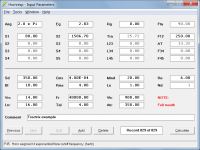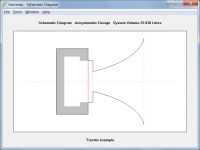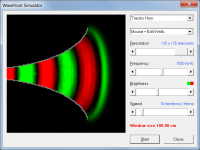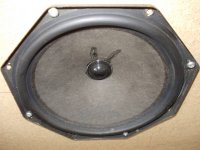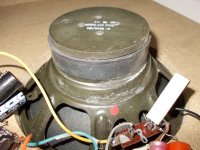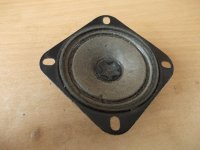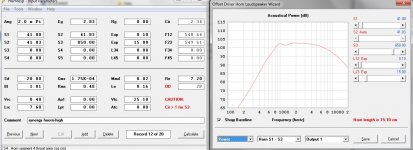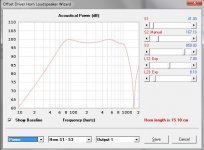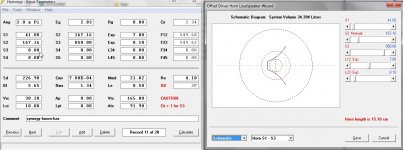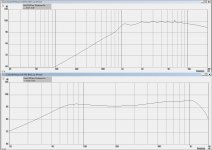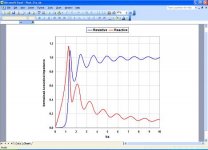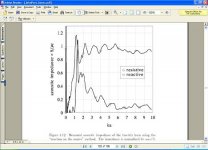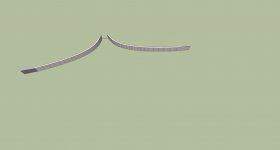You will never reach 15KHz when horn loading the PRV mid. You will start to see the high frequencies dropping off starting at around 1400Hz. Even with the narrowing directivity of the tractrix you will not get anything useful past about 5KHz. Not even a phasing plug will get you to 15KHz.
You are probably right - it is too much to ask a 5 in cone to act like a big CD without a phase plug. However, the F1 Axehead tops use a single 5 in driver with a phase plug and achieve 15kHz, you cannot categorically say that "Not even a phasing plug will get you to 15KHz."
http://www.funktion-one.com/dl/files/R1_web.pdf
The F1 achieves 112dB sensitivity with the 5 in driver so about the same ball park as what I am coming up with in the simulations.

How to sim tractrix with horrnresp?
In Edit mode, highlight the L12 input field and then press the T key to specify the Tra (tractrix) option.
Attachments
a tractrix is only possible to be approximated in Akabak with many segments - and produces the nice flat response all the way up to HF.
A word of caution - AkAbak uses a plane wavefront model in all cases.
An isophase model is really required to accurately simulate a tractrix horn having a fully formed mouth (Fta = 90 degrees).
Attachments
A word of caution - AkAbak uses a plane wavefront model in all cases.
An isophase model is really required to accurately simulate a tractrix horn having a fully formed mouth (Fta = I 90 degrees).
Thanks - I will have to try HR with the PRV 5in driver to see what it predicts for the response. Very cool to see that you have a single line option to simulate a Tractrix.
I think there is a radial horn radiator option that may provide an iso phase output. It will require a curved outwardly protruding horn mouth though.
Last edited:
That is a nice flat wide response. That profile is not a tractrix though (looks more like a Danley Synergy expansion) - a tractrix is only possible to be approximated in Akabak with many segments - and produces the nice flat response all the way up to HF. Your driver looks way bigger than the horn in the diagram - is that physically a feasible plan?
What Phillips driver are you using?
I do use the AD 8066 after measure TH params. I did also try a eminence low qts but that did not wel, go not to 80 Hz.
I have also done the exp in hornresp, and use a visaton cone tweeter for the high driver. it is for home, so not 130 dB+.
Attachments
In Edit mode, highlight the L12 input field and then press the T key to specify the Tra (tractrix) option.
Hi David, I did miss you, thanks for you explaning of the tractrix.
regards
kees
I have get screen picture of the exp horn flare tryout, I do want to use two straight flat boards on two side of the horn like in post 1716 or 1709 so not square horn as you most see. I do use two phillips and one cone tweeter. post 1716 I do like to test, two flat surfaces for the two woofers.
If horn looks to small, it soms also good when made bigger, I have to export and see what happens.
If horn looks to small, it soms also good when made bigger, I have to export and see what happens.
Attachments
A word of caution - AkAbak uses a plane wavefront model in all cases.
An isophase model is really required to accurately simulate a tractrix horn having a fully formed mouth (Fta = 90 degrees).
Here is the "Horn" radiator element in Akabak that is non-planar - and it predicts the following response:
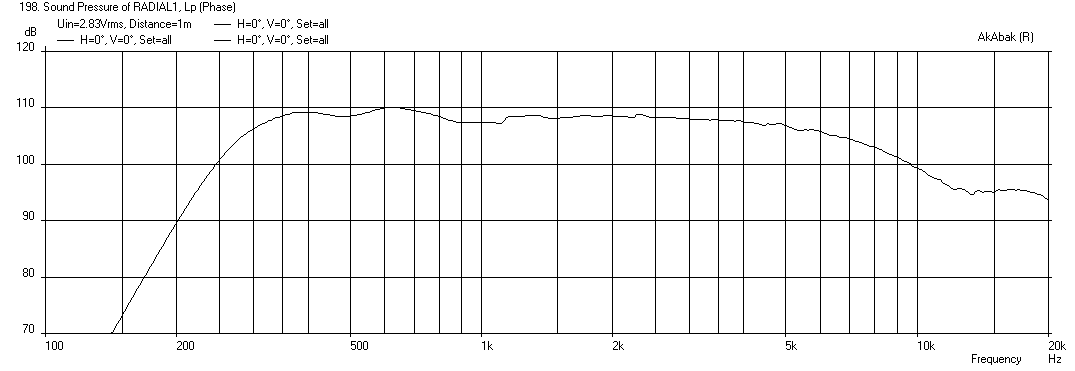
Now there is falloff of about -12dB from 5kHz to 15kHz but still useable.
You will never reach 15KHz when horn loading the PRV mid. You will start to see the high frequencies dropping off starting at around 1400Hz. Even with the narrowing directivity of the tractrix you will not get anything useful past about 5KHz. Not even a phasing plug will get you to 15KHz.
Martinsson stuck a 2in fullrange Tang Band driver on a JBL horn and got the following response which clearly shows usable output to 15kHz:


More info in this thread: http://www.diyaudio.com/forums/full-range/205146-2-madness-hornloading-tb-w2-803sm.html
I did a sim with akabak, use of old 1976 phillips AD8066 woofer and a scan speak D2905 tweeter with a Fs of 500 hz.
so on sim it looks oke for a two way synergy home use, like home theatre, and afcourse a tapped horn as a sub.
And now i go on with the rover P6 repairs.
regards
kees
so on sim it looks oke for a two way synergy home use, like home theatre, and afcourse a tapped horn as a sub.
And now i go on with the rover P6 repairs.
regards
kees
Attachments
I did a sim with akabak, use of old 1976 phillips AD8066 woofer and a scan speak D2905 tweeter with a Fs of 500 hz.
so on sim it looks oke for a two way synergy home use, like home theatre, and afcourse a tapped horn as a sub.
And now i go on with the rover P6 repairs.
regards
kees
That is an impressive response from your Phillips woofer. Where is the injection port and what dimensions are you using for the horn? Are these the same dimensions as used in post 1733 above? I have yet to see anything that wide and smooth with such high sensitivity - are you also using the bass reflex rear chamber on the Phillips to get bass that low?
You are probably right - it is too much to ask a 5 in cone to act like a big CD without a phase plug. However, the F1 Axehead tops use a single 5 in driver with a phase plug and achieve 15kHz, you cannot categorically say that "Not even a phasing plug will get you to 15KHz."
http://www.funktion-one.com/dl/files/R1_web.pdf
The F1 achieves 112dB sensitivity with the 5 in driver so about the same ball park as what I am coming up with in the simulations.
I'd like to see an actual measurement and know under what conditions they were made. You did notice how restricted the directivity is on that speaker, right? 112dB sensitivity over a 5 octave bandwidth starting at 520Hz is not remotely believable. If you do some searching and read the remarks from people that are reputable the Funktion speakers receive less than favorable reviews.
Martinsson stuck a 2in fullrange Tang Band driver on a JBL horn and got the following response which clearly shows usable output to 15kHz:
More info in this thread: http://www.diyaudio.com/forums/full-range/205146-2-madness-hornloading-tb-w2-803sm.html
That is only an on axis measurement. Once you get a few degrees off axis it will drop like a rock. Completely unusable for any practical listening environment. I enjoy your enthusiasm, but you need to remain more well grounded and understand what context the data was generated from. Efficiency Bandwidth Product is a finite number. You can't have a +100dB speaker that covers multiple decades with wide dispersion.
Look at the spec sheet for the JBL 2386 horn: http://www.sound-image.com/wp-content/uploads/JBL_2386.pdf
Once again you notice the restricted directivity? The directivity index goes from 5.4 at 300Hz and up to a staggering 19.50 at 20KHz. Of course it will look good on axis. However, go off axis by just a few degrees and the illusion falls apart. Not to mention the vertical coverage drops to only 15 degrees at 10KHz.
Last edited:
I'd like to see an actual measurement and know under what conditions they were made. You did notice how restricted the directivity is on that speaker, right? 112dB sensitivity over a 5 octave bandwidth starting at 520Hz is not remotely believable. If you do some searching and read the remarks from people that are reputable the Funktion speakers receive less than favorable reviews.
Yes, measurements would be nice to see. I realize directivity will be limited but that is one of the design goals of pro sound horns - to direct it in a certain direction. I have heard first hand review from someone very experienced and I trust who has used this and he says it is one of the better tops out there. Good point about bandwidth product - there is no free lunch. As I will build in foam core prototype first there won't be too much of a loss if it doesn't pan out. If the foam works with the 5in fullrange then in will consider adding the 12in drivers in a plywood build.
I think there is a radial horn radiator option that may provide an iso phase output.
The throat acoustical impedance of the AkAbak horn element is determined using the standard Webster plane wavefront model. It is in effect a waveguide element terminated by a radiation element, both of which assume plane wavefronts when calculating acoustical load (and hence acoustical output power).
Because of the relatively rapid flaring rate of a tractrix horn, particularly near the mouth, it is more accurately simulated using an isophase model (which is not possible with AkAbak).
Attachment 1 shows the throat acoustical impedance of a tractrix horn predicted using the Hornresp isophase model.
Attachment 2 shows the measured throat acoustical impedance for the same horn.
The parameters of the test horn are:
Ang = 2.0 x Pi
S1 = 20.27 sq cm
S2 = 2307.22 sq cm
L12 (Tra) = 55.90 cm
The Hornresp data was exported to Excel and converted to show values of ka (2 x Pi x f / 34400 x 27.1) rather than frequency along the x-axis, to make it easier to directly compare predicted and measured results.
Attachments
The throat acoustical impedance of the AkAbak horn element is determined using the standard Webster plane wavefront model. It is in effect a waveguide element terminated by a radiation element, both of which assume plane wavefronts when calculating acoustical load (and hence acoustical output power).
Because of the relatively rapid flaring rate of a tractrix horn, particularly near the mouth, it is more accurately simulated using an isophase model (which is not possible with AkAbak).
Attachment 1 shows the throat acoustical impedance of a tractrix horn predicted using the Hornresp isophase model.
Attachment 2 shows the measured throat acoustical impedance for the same horn.
The parameters of the test horn are:
Ang = 2.0 x Pi
S1 = 20.27 sq cm
S2 = 2307.22 sq cm
L12 (Tra) = 55.90 cm
The Hornresp data was exported to Excel and converted to show values of ka (2 x Pi x f / 34400 x 27.1) rather than frequency along the x-axis, to make it easier to directly compare predicted and measured results.
That is a really nice agreement between model and experiment. If you put it into excel why not overlay the measured data as points on the solid curves which are predictions? I have to admit that I am new to acoustic impedance measurements and tried thinking about how one would actually measure them. It appears to be not a trivial matter as the paper referenced below shows. It turns out that I actually have done a similar measurement to examine pressure fluctuations due to acoustic instabilities in gas turbine engine test stands where a small dia semi infinite length tube is tapped to the wall of the duct under test and a mic T'd to the tube was used to measure pressure fluctuations. Anyhow, I guess you are showing the acoustic impedance because it shows most directly whether or not one is modeling a particular horn expansion profile correctly. Can Hornresp simulate a tractrix that is flat walled on two sides and curved on two sides like the Edgar horn? Or it doesn't matter as long as the CSA vs distance follows a tractrix expansion?
Thanks for explaining this to me.
Regards,
X
Paper on acoustic impedance measurement.
http://www3.alcatel-lucent.com/bstj/vol11-1932/articles/bstj11-3-402.pdf
Last edited:
That is an impressive response from your Phillips woofer. Where is the injection port and what dimensions are you using for the horn? Are these the same dimensions as used in post 1733 above? I have yet to see anything that wide and smooth with such high sensitivity - are you also using the bass reflex rear chamber on the Phillips to get bass that low?
I have drawn the horn but is is short, but very wide, (1 meter), with heigh is 10 cm.
I do try more height to see what happens, I do not understand the throat is so wide, while for he high it is much smaller, hornresp do take this with them
regards
Attachments
- Home
- Loudspeakers
- Multi-Way
- Suitable midrange cone, for bandpass mid in Unity horn.
